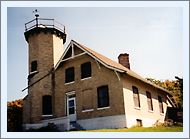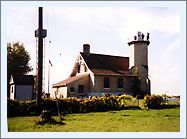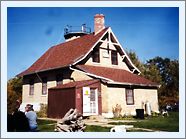|
Historical Information

With the arrival of the 1860's, Green Bay was booming. With over 35
sawmills operating at the mouth of the Fox River, the town of Green Bay
was fast becoming one of the Great Lakes preeminent lumber shipping
ports, and the peninsula communities of Fish Creek, Ephraim and Sturgeon
Bay were also growing as they shipped fish, lumber and stone throughout
the Great chain of lakes. Vessels entering Green Bay from Deaths Door
quickly established two separate southbound lanes dependent on their
destinations, with Chambers Island serving as a critical landmark for
both. Vessels bound for the peninsula harbors took a narrow
passage known as the Strawberry Channel immediately to the east of
Chambers Island, while those headed to the foot of the bay
swung southwest out of Deaths Door' taking deeper water to a point west
of Chambers Island, where they swung south to Green Bay.
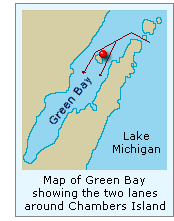 As a result of pleas from maritime
interests for the improvement of aids to navigation in the western Great
Lakes, the Lighthouse Board dispatched a special committee to evaluate
navigational needs in the area in 1865. As part of its evaluation, the
committee recommended that lights be established on Whaleback Shoal (now
known as Peshtigo Reef), Grassy Island and on Chambers Island. Congress
responded with an appropriation of $25,000 authorizing the construction
of these lights on July 28 of the following year. However the Board
quickly recognized that the amount of the appropriation was
insufficient, as their latest estimates indicated that $15,000 would be
needed for the construction of a light on Chambers Island alone. As a result of pleas from maritime
interests for the improvement of aids to navigation in the western Great
Lakes, the Lighthouse Board dispatched a special committee to evaluate
navigational needs in the area in 1865. As part of its evaluation, the
committee recommended that lights be established on Whaleback Shoal (now
known as Peshtigo Reef), Grassy Island and on Chambers Island. Congress
responded with an appropriation of $25,000 authorizing the construction
of these lights on July 28 of the following year. However the Board
quickly recognized that the amount of the appropriation was
insufficient, as their latest estimates indicated that $15,000 would be
needed for the construction of a light on Chambers Island alone.
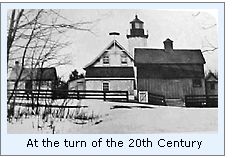 With no additional appropriation
forthcoming, and deeming the need for a light on Chambers Island to be
critical, the Board decided to move ahead with construction on the
island, while delaying work on the other sites until additional funds
could be obtained. In May of 1867, a 40-acre reservation on the north
end of the island was purchased from sawmill owner Lewis S. Williams for
the sum of $250. Williams had been born in New York in 1821, and had
moved to Mackinac Island with his family around 1840. Lewis & his wife Anna Hoag moved to Chambers Island
in 1850, following the footsteps of Anna's father, who had been the first permanent settler on the island
in 1848. With no additional appropriation
forthcoming, and deeming the need for a light on Chambers Island to be
critical, the Board decided to move ahead with construction on the
island, while delaying work on the other sites until additional funds
could be obtained. In May of 1867, a 40-acre reservation on the north
end of the island was purchased from sawmill owner Lewis S. Williams for
the sum of $250. Williams had been born in New York in 1821, and had
moved to Mackinac Island with his family around 1840. Lewis & his wife Anna Hoag moved to Chambers Island
in 1850, following the footsteps of Anna's father, who had been the first permanent settler on the island
in 1848.
With the delivery of materials and a working party,
work began on the island the following June. The plans for the Chambers Island Light
Station called for a virtual twin of the structure being built that same
year at Eagle Bluff, with one important exception. While the light at
Eagle Bluff was designed with a square tower, this tower was to be
octagonal in plan, in order to visually differentiate the two structures
and reduce any potential confusion to mariners. Built atop a cellar
excavated in the rough gravel that constitutes the island, the Cream
City brick structure's forty-two foot tall tower was diagonally
integrated into the corner of the dwelling. A circular inner brick wall
within the tower contained a set of 55 cast-iron spiral stairs which
wound from the cellar to the lantern. With landings on the first and
second floors, these stairs also served as the only method of moving
between the floors within the dwelling.
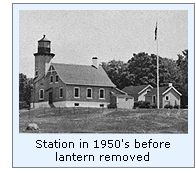 The tower was capped with an octagonal
gallery on which a decagonal prefabricated iron lantern was centered.
The clockwork mechanism rotated the station's Fourth-Order Fresnel
lens to
provide a characteristic fixed white light varied by a flash every sixty
seconds, and it's 68-foot focal plane provided a visibility range of
sixteen miles on clear nights. The tower was capped with an octagonal
gallery on which a decagonal prefabricated iron lantern was centered.
The clockwork mechanism rotated the station's Fourth-Order Fresnel
lens to
provide a characteristic fixed white light varied by a flash every sixty
seconds, and it's 68-foot focal plane provided a visibility range of
sixteen miles on clear nights.
While most keeper's were promoted to
the position of keeper after previous service as assistants, Lewis
Williams was appointed directly as the station's first keeper. It must
be remembered that these were days of politically expedient
appointments, and it is likely that William's sold his land to the
Government with the understanding that he would be appointed as the
station's first keeper. Williams, his wife, and their eleven children
moved into the dwelling, and carefully threading the family bedroom
furniture up the tightly-spiraling stairs. Williams exhibited the new
light for the first time on the evening of October 1, 1867.
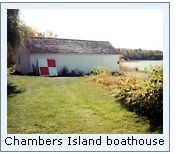 In 1892, as a result of falling lake
levels, the station's boathouse was relocated 16 feet closer to the
receding shore, and a new landing crib was built. Sidewalks were
replaced and a 45-foot deep well with a windmill-powered pump and a
2,250-gallon holding tank were installed, bringing running water into
the dwelling for the first time, and eliminating the need to draw water
from the lake on a daily basis. Evidently, the water levels in Green Bay
continued to decline, as the boat house was moved 75 feet further toward
the shore in 1897. In 1892, as a result of falling lake
levels, the station's boathouse was relocated 16 feet closer to the
receding shore, and a new landing crib was built. Sidewalks were
replaced and a 45-foot deep well with a windmill-powered pump and a
2,250-gallon holding tank were installed, bringing running water into
the dwelling for the first time, and eliminating the need to draw water
from the lake on a daily basis. Evidently, the water levels in Green Bay
continued to decline, as the boat house was moved 75 feet further toward
the shore in 1897.
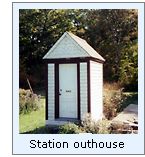 The Lighthouse Board decided that the
characteristic of the station's light needed modification, and a new
Fourth Order lens, clockwork and pedestal with a mercury float were
delivered to the station in 1898. The Ninth District Lampist arrived and
installed the mechanism in the tower the following year. Exhibited for
the first time on the night of July 15, 1899, the virtual friction-free
rotation resulting from the mercury float system allowed the new lens to
be rotated at twice the speed of the original mechanism, providing the
new characteristic of a fixed white light varied by a two-second flash every
thirty-seconds. The Lighthouse Board decided that the
characteristic of the station's light needed modification, and a new
Fourth Order lens, clockwork and pedestal with a mercury float were
delivered to the station in 1898. The Ninth District Lampist arrived and
installed the mechanism in the tower the following year. Exhibited for
the first time on the night of July 15, 1899, the virtual friction-free
rotation resulting from the mercury float system allowed the new lens to
be rotated at twice the speed of the original mechanism, providing the
new characteristic of a fixed white light varied by a two-second flash every
thirty-seconds.
Life for the keeper improved
dramatically in 1926 when an acetylene illuminating system was installed
in the tower. Equipped with a sun valve, the acetylene gas was
automatically turned on at night and off at dawn, and with no wick,
required significantly less observation and maintenance during the
night.
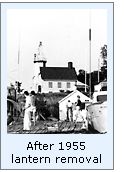 The US Coast Guard assumed
responsibility for the nation's aids to navigation in 1929, and in an
attempt to reduce cost automated the Chamber's Island light in 1955
through the removal of the lantern from the gallery and the erection of an electrically-powered light atop a 30-foot
steel skeletal structure in its place. The US Coast Guard assumed
responsibility for the nation's aids to navigation in 1929, and in an
attempt to reduce cost automated the Chamber's Island light in 1955
through the removal of the lantern from the gallery and the erection of an electrically-powered light atop a 30-foot
steel skeletal structure in its place.
The Coast Guard constructed a 67-foot
steel tower between the shore and the station in 1961. Painted black and
outfitted with a diamond-shaped daymark, the tower is equipped with a
modern solar-powered optic, and displays a flashing white light every
six seconds, visible for a distance of 12 miles. With construction
of this new steel tower, the pole was removed from atop the original
structure, and the old tower stood dark at night after ninety-three
years of faithful service.
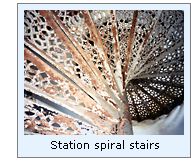 The Coast Guard deeded the lighthouse
reservation and buildings to the town of Gibraltar in 1976, for use as a
park, and the lighthouse was opened to the public the following year.
Joel and Mary Blahnik and their family have lived in the keepers
dwelling every summer since, and have worked at restoring the buildings
and creating a museum within the keeper's dwelling. The Coast Guard deeded the lighthouse
reservation and buildings to the town of Gibraltar in 1976, for use as a
park, and the lighthouse was opened to the public the following year.
Joel and Mary Blahnik and their family have lived in the keepers
dwelling every summer since, and have worked at restoring the buildings
and creating a museum within the keeper's dwelling.
It has been widely reported that the
Fourth Order lens
assembly from Chambers Island was sold to
Harold Warp of Chicago in 1958, and was subsequently displayed in his Pioneer
Village museum in Minden, Nebraska. However, during their August 21,
2001 visit to Minden Al and Helen Gademsky of the Fresnel Research
Team found that while the Pioneer Village had three Fresnel lenses
on display, all three of them were Sixth Order
lenses, and thus could
not have come from Chambers Island.

Keepers of this Light

Click Here to see a complete listing of
all Chambers Island Light keepers compiled by Phyllis L. Tag of Great
Lakes Lighthouse Research.

Seeing this Light

Unfortunately, our hectic field trip schedules have thus far prevented
us from visiting this light. The deeding of the grounds to the town of
Gibraltar in 1896 serves as an early example of the successful transfer
of ownership to a local entity. With interest in lighthouses increasing,
and the population becoming increasingly aware of the historical
importance of these magnificent structures, we can dream that some day
funds will be obtained to fabricate a new lantern for the tower, and
return the station to it's original glory.

Finding this
Light

The station is open to the public on most days, however the only way to
get out to the island is by private boat or via a charter captain.

Reference sources

Annual reports of the Lighthouse Board, 1866-1909
Fish Creek Voices, edited by Edward & Lois Schreiber, 1990
Author's discussions with Eagle Bluff docent during 2000 field trip.
Coast Guard Historian's office archives.
Great Lakes Light List, Department of Commerce, 1924
Great Lakes Coast Pilot, NOAA, 2000.
09/11/01 email from Al & Helen Gademsky on their visit to Warps
Pioneer Village.
Email correspondence with Terri Boucher, 7/29/01
Photographs taken October 2001 courtesy of Tom Williams and
Michigan State Archive, Lighthouse photography collection.
Keeper listings for this light appear courtesy of Great
Lakes Lighthouse Research
|
